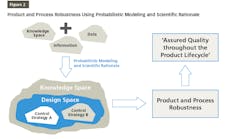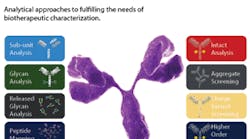The advantages of a ‘Quality by Design’ approach in pharma drug development
Quality by Design (QbD) brings a systematic approach to drug development that aims to ensure quality by applying analytical and risk-management methodologies to the design, development and manufacturing of new medications. At its core, the approach looks to design quality into workflows up front. A product’s objectives and essential attributes are defined during the initial stages of a program, with risk and data analysis then used to understand how processes can affect a product’s characteristics. As a result, QbD provides a robust framework for the design and implementation of processes that achieve a consistent level of quality and meet the pre-defined standards.
Although pharmaceutical development has historically focused on a “quality by QC” approach, whereby emphasis is placed only on the final control and release of a product, the QbD approach builds quality into the product itself. This is done by performing development with a complete understanding of the product and its manufacturing processes, while also ensuring a deep understanding of the risk involved in the processes and the requirements to mitigate these.
This article explores some of the advantages a QbD approach can bring to drug development programs and how it can ensure more robust commercial manufacturing methods for consistent production of quality medications.
Continuous improvement
QbD can ensure a safe and effective drug supply, while also significantly improving the quality of manufacturing performance. It is based on the principle of continuous improvement and the growing need for manufacturing organizations to increase their understanding of products and benefit from the growing knowledge base that develops as a product moves through its lifecycle. The approach allows for organizations to continuously improve their development strategies and make on-going adaptations. This ensures that the root causes of any manufacturing problems are satisfactorily addressed and corrected as a project moves through scale-up from the lab, to the pilot plant and to commercial manufacturing.
In each development phase, the level of knowledge increases and the risk assessment can be refined and updated, giving the opportunity to correct any possible issues. Even when a product has been commercialized, the opportunity for continuous improvement does not cease, with new experience gained and data gathered that can still serve to fine tune the process and the product.
Final processes must offer a robust and reliable performance, with statistical tools employed to identify these robust conditions. During the development phase, for example, design of experiments (DOE) are useful to identify the impact of important factors and interactions. When critical factors can be identified in advance, it is easier to perform risk mitigation actions and, subsequently, avoid rejection of batches. Additionally, DOE is used to find optimal process conditions and define limits for various process parameters.
Change control
Improved capabilities to support change is where the QbD approach comes into its own. If quality is built inside a product development process, the updating of regulatory documentation following any manufacturing process adaptations may only require minor variations to be made. This is because a deep knowledge of the process and its parameters has already been established and data has been collected to support any updates. This differs from the old approach, where change was avoided due to the potential of product quality being negatively impacted. With a sound understanding of the product and its processes, it will be easier to determine which changes are acceptable and which ones should be avoided.
By gathering all the information and knowledge collected during the development phase, it is possible to establish a design space, which, as described in The International Conference on Harmonization of Technical Requirements for Registration of Pharmaceuticals for Human Use (ICH) Pharmaceutical Development Q8 (R2) document, is a domain that always produces a product with specified characteristics. According to ICH Guidelines, design space involves the multidimensional combination and interaction of input variables and process parameters that have been demonstrated to provide assurance of quality. When operating inside such established design space, and it is necessary to perform minor variations or deviations in relation to the target manufacturing process due to technical reasons, it can be ensured that the process remains robust and a final drug product that meets satisfactory quality requirements can still be obtained.
This allows a level of freedom to change the process, as long as it will not impact the characteristics of a product and is in contrast to a traditional ‘Quality by QC’ approach. Here, it is unknown what impact the change may cause, and it cannot be ruled out that it may result in product with unacceptable properties. This may result in a major regulatory variation with the need for new data to be collected which can have both time and cost implications.
Failure prevention
The QbD approach can provide manufacturing teams with a better understanding of the parameters of the development process. This means that the team may be able to fine tune certain aspects of the process if they were foreseen during the development and registered to the appropriate regulatory authority. Continuous fine tuning and redirection of the process can more consistently and accurately achieve results closer and closer to the target value.
Having a deep understanding of how the process parameters work and are interlinked may also make it less likely for batch failure to occur as a result of unexpected reasons, as all possible interactions have already been evaluated and are already known. This may have the added benefit of reducing overall costs.
QbD focuses on the use of multivariate analysis. This is usually in combination with modern process-analytical chemistry methods and knowledge-management tools to enhance the identification and understanding of critical attributes of materials and vital parameters of the manufacturing process. Using multivariate tools to follow batch performance with real-time measurements and then presenting the results in multivariate control-charts will advise process engineers if the batch is operating normally or if there is an early drift in the performance. The ability to detect any deviations early is important so that actions can be taken to get the process back to normal operating conditions before it is no longer possible. This enhanced understanding of product and process can be used to build quality into manufacturing and provide the basis for continuous improvement of products and processes. To this end, there will be fewer rejected batches, which is positive for both the production economy and the environment.
Consistency
Designing quality inside the process will ensure greater batch-to-batch consistency. This proven consistency will help instil better regulatory confidence in the robustness of both the process and product. This may allow for less intense regulatory oversight during registration, as well as less post-approval submissions and requests.
From the consumer perspective, the QbD approach affords greater consistency of medications and reduced risks of recalls occurring, increasing patient confidence and trust in manufacturers.
Right first time
One of the goals of the QbD approach is to increase the chances of product registration being “right first time.” QbD ensures that all sources of variability affecting a process are identified, explained and managed by appropriate measures. This ensures that products consistently meet predefined characteristics and are “right first time.”
Success first time not only means lean asset management for organizations but ensures that efforts are concentrated in the right areas. It also means a shorter time to market due to the quicker registration and approval processes.
Reduced controls
Possessing an extensive understanding of the processes provides a good indication of the quality of manufactured products prior to even testing them as the assurance of quality has already been built in. This reduces the need for controls over the intermediates and final products because real-time controls exist within the process itself. For both manufacturing organizations and their customers, this reduces time for manufacturing, testing and release, while also reducing costs.
Final thought
QbD will become of greater importance as forward-thinking companies look to boost their production capabilities, reduce throughput times and adopt more continuous manufacturing processes. In this progressively non-stop manufacturing environment, QbD uses a data-driven approach to deliver better understanding of manufacturing processes, reduced likelihood of batch failures, more efficient and effective control of change, as well as greater return on investment, time and cost savings. As regulatory authorities begin to demand that manufacturers design quality into products at every stage of development and manufacture, the use of QbD will become increasingly critical.






